Payment Reschedule [U0104]
Contents
- Payment Reschedule Screens
- CPI - Payment Reschedule Exception Report
- RSC - Payment Reschedule Audit Report
Introduction
The
Payment Reschedule update allows mid-term changes to financial information (e.g.,
payment schedule, security deposit) of precomputed interest type leases, operating
leases, and interest bearing loans. For precomputed leases and interest bearing
loans of P&I (principal and interest) type, the yield to maturity is automatically
recalculated based on the changes made in this update.
Payment Reschedule
cannot be applied to a non-accrual lease.
There are four methods of
mid-term changes:
- Individually, lease-by-lease (RSC).
- Mass changes based on the user’s selection criteria (CPI). Mass changes are for precomputed leases only.
- Deferred payment reschedule (DEF).
- Deferral reversal (DEFR).
- RE-Write payment reschedules (RWT).
When making individual adjustments, the following financial information may be changed:
- Security deposit
- Book initial direct cost (IDC)
- Insurance premium
- Residual (for each asset of precomputed leases)
- Remaining term (indirectly via payment schedules)
- Estimated remaining term (for month-to-month leases)
- Remaining payment schedule (number, frequency and amount of payments)
When adjusting multiple leases, only the remaining payment schedule may be adjusted.
Using the float index assigned to the lease and the current floating rates (as
stored through the Base Rates update [U0705]), an additional charge is computed
and added to each payment remaining. This option may be used if the lease agreement
has a built-in payment adjustment (e.g., based upon the Consumer Price Index).
If a payment reschedule is to adjust payments already accrued, use the
Accrual Reversal option of the Cycle Accruals update [U0301] to reverse accruals,
before making the adjustment through the Payment Reschedule update [U0104]. In
this case, only the RSC adjustment method may be used.
If a payment
reschedule involves a lease on which a principal paydown was made, the paydown
amount must be considered in determining new payment amounts.
If the
lease accrual method is of a precomputed type, and the Payment Reschedule update
is used to reduce (write down) the Residual of the lease, a special calculation
will be used to recognize a portion of the write down as a loss while maintaining
the yield (APR) over the remaining term of the lease.
The method used
for residual write down affects the same G/L accounts for all the finance lease
precomputed accrual methods. The G/L transaction will be:
General Ledger Account
Amount
DR Loss on Sale
Present Value of the Residual Write Down
CR Unguaranteed residual
DR Unearned Income
Balance of Residual Write Down
CR Unguaranteed residual
The
PV (present value) of the residual write down is also the change in accrued principal.
The balance of the residual write down will be the remaining difference between
the amount of the residual to the write down less the present value of the residual.
For example, if a lease has a 12% yield for 12 months and a $20,000
residual being written down to $15,000, with 9 months remaining on the lease,
the PV of the residual is (using an HP12c with the PV calculation):
5,000 FV <== Future Value
12 g i <== Enter Interest Rate (Yield) @ 1.0% per month (12% per annum)
9 n <== (Remaining) Term
PV <== Present Value
4571.70 <== Result
5,000 - 4,571.70= 428.30
The journal entry for this write down would be:
General Ledger Account
Amount
DR Loss on Sale
$4571.70
CR Unguaranteed residual
DR Unearned Income
$428.30
CR Unguaranteed residual
The accrued principal
will also be reduced by the PV, or $4571.70. The yield will remain the same. For
non-monthly leases, the write-down can only be processed on an accrual month.
There will be a difference in the yield after the residual write-down,
but in most cases it will be less than a basis point (one hundredth of a percent
.0001). However, if the lease accrual method is not AAPR or RAPR, then a residual
write down will result in a change to the yield that exceeds the expected “.0001%”
(+ or -). Other precomputed methods such as Rule of 78 and Straight line do not
earn income using level yield (APR) method. Therefore, the yield shown for these
other precomputed accrual methods is informational only and is not used to calculate
the monthly income amounts.
When the Cash Control module is purchased
and a Payment Reschedule is made to the lease, LeasePak will automatically assign
a trace reference information when a security deposit is received from the Payment
Origination code. The trace reference will appear in the Cash Control Payment
History [R0926] report.
When a Suspense item has been tied to the lease
that is being rescheduled, LeasePak will automatically default the trace reference
information to the Suspense Review [R0203] report.
Payment Reschedule Selection

This
screen is used to specify lease(s) to be rescheduled.
A specific lease
number must be entered for adjustments to an individual lease.
A float
rate adjustment may be made to all leases, a selection of leases (such as all
leases for portfolio 1), or an individual lease. Before using the float rate adjustment,
a float index must be assigned to each lease through the Book Lease option of
the New Lease update [U0101] or through the Master Financial update [U0202], and
float indices must be established through the Base Rates update [U0705].
If the Notes Payable module is purchased and if an active note is attached
to the lease, a warning message will be displayed.
Field Descriptions
- ALL
Enter X to select all leases for a float rate adjustment. Leave blank to enter a selection of leases or a specific lease number.
- PORT
Enter the number of the portfolio for a float rate adjustment. Leave blank if adjusting all leases or entering a specific lease number.
- COMP
Enter the number of the company for a float rate adjustment. Leave blank if adjusting across companies or entering a specific lease number.
- REGN
Enter the number of the region for a float rate adjustment. Leave blank if adjusting across regions or entering a specific lease number.
- OFFIC
Enter the number of the office for a float rate adjustment. Leave blank if adjusting across offices or entering a specific lease number.
- LEASE
Enter the lease number. Leave blank if adjusting multiple leases for float rate.
Adjustment Method, Processing
Month
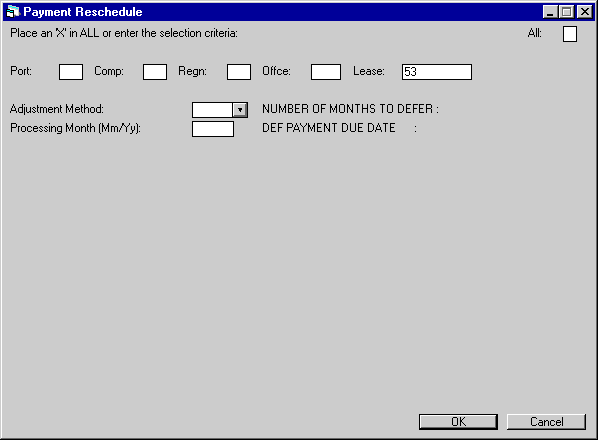
This screen is used to select the adjustment method and, if required, the processing month. PROCESSING MONTH is necessary only for the CPI ADJUSTMENT METHOD.
Field Descriptions
- ADJUSTMENT
METHOD
These are the valid methods:
- RSC
Allows changes to security deposit, book initial direct cost, insurance
premium, residual (precomputed leases only), and the remaining portion
of the payment schedule. PROCESSING MONTH is not accessible.
Additionally, this adjustment method calculates the Turn-In Date for the lease +1 day after the Maturity Date.
- CPI Used
when the payment amounts for the remainder of the payment schedule are
adjusted by adding an amount that depends on a float rate index, such
as the consumer price index. Use this method to make an annual lease anniversary
adjustment to a lease or group of leases.
Leases to be adjusted must meet 3 criteria:
1) Lessor accrual method must be one of the precomputed methods.
2) Lease must have a FLOAT INDEX code. (Refer to Book Lease update [U0101] for coding.)
3) Month portion of LEASE DATE must match month portion of PROCESSING DATEAdjustments are calculated as follows:
First, LeasePak calculates the average base rate during the processing month entered for the financial institution coded as the lease’s float index.
Next, LeasePak multiplies future payment amounts for the lease by that average percentage to get an additional amount.
Finally, LeasePak adds the calculated amount to each future payment.
For example, if 09/95 is entered as the PROCESSING MONTH, all leases with a LEASE DATE in September of any year before and including 1995 have their future payment amounts adjusted upward. If such a lease’s FLOAT INDEX is coded 2, and 2 represents Morgan Prime, then that lease’s rents will be adjusted by the average float rates in September 1995 for Morgan Bank.- DEF Deferrals
are used when the lease will go through the extension/deferment criteria
eligibility. LeasePak will prompt the user to enter both a non-zero number
of months to defer and a valid month to start the deferment from. If the
last accrued to date is later than the processing month an accrual reversal
from the last accrued to date month will be made. It will automatically
insert a SKIP for every month deferred and by default move the deferred
monthly payment into a balloon payment on the final payment due date.
- DEFR Deferral
Reversals may be performed when the following criteria is met:
1) The last payment reschedule performed on the lease (the current payment schedule is different from the one right after the last deferred payment reschedule).
2) There are no partial or full payments applied to the invoice on or after the deferral month or the accrual to date, whichever is earliest.
3) If the deferral is for a Security Deposit or Deferment Fee.
If Security Deposit or Deferral Fees are invoiced the following rules are applied:
1) If fees have not been fully or partially paid through Payment [U0102], Batch Payments [U0305] or Cash Control [U0126], and the fee amounts have not been changed through Assessments [U0105], then no further processes need to be made.
2) If the fees have been fully or partially applied via the above named updates, the Payment Reversal must be made to reverse the payment.
3) If the fee amount has been changed through Assessments [U0105], the fee amount must be changed back to the original value. An error message will appear displaying the Original Fee amount. - RSC
Allows changes to security deposit, book initial direct cost, insurance
premium, residual (precomputed leases only), and the remaining portion
of the payment schedule. PROCESSING MONTH is not accessible.
- RWT Rewrite
allows changes to security deposit, book initial direct cost, insurance
premium, residual (precomputed leases only), and the remaining portion of
the payment schedule, the date of the last rewrite and the number of rewrites
will be stored.
Additionally, this adjustment method calculates the Turn-In Date for the lease +1 day after the Maturity Date.
- PROCESSING MONTH (MM/YY)
This field is accessible only if the CPI ADJUSTMENT METHOD is entered. This date has two effects:
- Only leases within the selection criteria whose LEASE DATE month is the same as the month entered here are adjusted
- The percentage used in calculating the float rate adjustment is the average rate for the PROCESSING MONTH.
CPI - Verification

This
screen is used to verify the CPI adjustment to be performed. The adjustment percentage
displayed is the percentage for the first lease in the selection. If other leases
in the selection have a different FLOAT INDEX the adjustment percentage used may
be different than the one displayed here.
If the ADJUSTMENT METHOD is
CPI, this is the last screen to be displayed. An audit report is generated detailing
any leases whose payment reschedule for method CPI is not successful.
Field Descriptions
- ADJUST
PAYMENT SCHEDULE(S) (Y/N)?
If Y is entered, the selected leases are adjusted when RETURN is pressed.
RSC - Financial, Asset
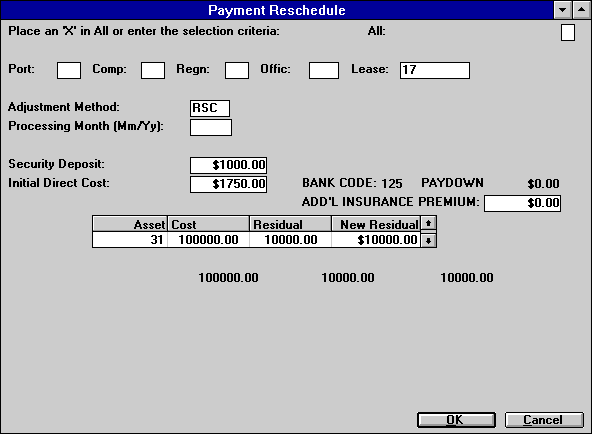
This
screen appears only if the ADJUSTMENT METHOD is RSC. It is used to change relevant
financial data for the asset and/or lease. The existing security deposit, book
IDC, asset number(s), asset cost(s), and asset residual value(s) for the lease
are displayed.
The asset information is not displayed for operating
leases.
Field Descriptions
- SECURITY
DEPOSIT
Change the security deposit for the lease, if desired.
If the lease is subject to advanced invoicing, any increase in security deposit must have already been received. LeasePak will not bill additional security deposit in these cases.
- CASH
RECEIVED (Y/N)?
This field appears only if the amount of the SECURITY DEPOSIT is increased. Enter Y if the additional deposit has been received.
- CASH TO BE
DISBURSED (Y/N)?
This field appears only if the amount of the SECURITY DEPOSIT is decreased. Enter Y if the decrease is to be disbursed.
-
INITIAL DIRECT COST
This is the Book IDC calculated by LeasePak. Increase it, if desired. INITIAL DIRECT COST may not be decreased.
Note: Neither Notary Fee (IDC2) nor IDR fields (Registration Fee, Vendor Subsidy, Opening Commission, Insurance Fee) can be adjusted on this screen.
- BANK
CODE
This field will appear if the Multiple Banks module has been purchased. It allows the user to specify which bank received or disbursed the cash. The default bank code is 125; valid entries are 1 or 125-144. The user may only modify this field if CASH RECEIVED or CASH TO BE DISBURSED is Y.
- PAYDOWN
This amount is used to pay down a portion of the outstanding principal of a precomputed lease. The PAYDOWN amount field will only be accessible for an RSC payment adjustment method. The paydown amount should not exceed the outstanding principal of the lease. The new contract receivable and the lessor unearned income will be adjusted by the paydown amount, which will be reflected in the following two G/L transactions.
General Ledger Account
Amount
DR Cash
PAYDOWN
CR Contract Receivable
DR Contract Receivable
NEW CONTRACT RECEIVABLE
-ORIGINAL CONTRACT RECEIVABLE
+ PAYDOWNCR Unearned Income
Note: A paydown is not allowed for RES method extended leases on a cash or accrual basis as these types of leases do not have contract receivable.
- ADDITIONAL
INSURANCE PREMIUM
Increase the Insurance Premium (IDC2) paid, if desired. The premium may not be decreased.
- ASSET
The number of each asset on the lease is displayed.
Not applicable to operating leases.
- COST
The acquisition cost of each asset on the lease is displayed. Total acquisition cost for all assets is on the total line.
Not applicable to operating leases.
- RESIDUAL
The current residual of each asset of the lease is displayed. Total residual for all assets is on the total line.
Not applicable to operating leases or interest bearing loans.
- NEW
RESIDUAL (scrolled area)
Change the residual value of any or all assets on the lease, if desired. Not applicable to operating leases or interest bearing loans.
RSC - Payment Schedule
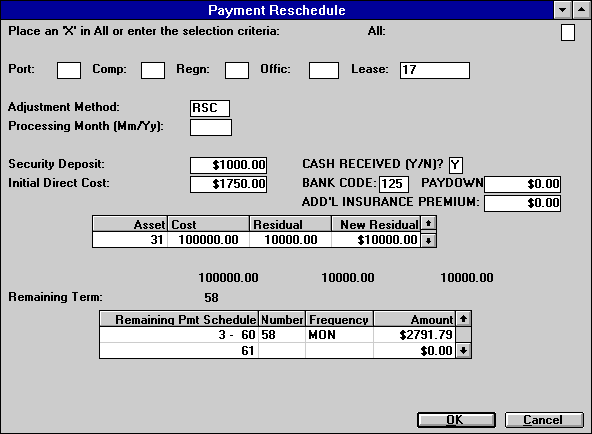
This
screen appears only if the ADJUSTMENT METHOD is RSC. It is used to change payment
schedule data for the remaining life of a lease.
Asset information is
not displayed for operating leases.
Field Descriptions
-
REMAINING TERM
The remaining term of the lease is displayed.
If the lease is a month-to-month lease, EST. REMAINING TERM is displayed in lieu of REMAINING TERM. The estimated remaining term is used to calculate the new monthly IDC allocation:UNAMORTIZED IDC
/ ESTIMATE REMAINING TERM - REMAINING
PAYMENT SCHEDULE
The remaining portion of the payment schedule is displayed. The starting and ending payment numbers for each line of the payment schedule are displayed.
If advanced invoices have been produced and are not yet accrued, they are ignored. Replacements for such advanced invoices will be created the first time accruals are run after the payment reschedule is processed.
- NUMBER (scrolled
area)
Change the number of payments, if desired. The remaining term of the lease may be changed by changing the number of payments remaining. The term may be lengthened or shortened.
If the lease is a fixed term lease with an automatic conversion to month-to-month, the NUMBER of the last payment schedule must be 999.
- FREQUENCY
(scrolled area)
Change the frequency of the payments, if desired. The remaining term of the lease may be changed by changing the frequency of the payments remaining. The term may be lengthened or shortened.
Valid payment frequencies are:MON Payments are due monthly (12 payments per year).
QTR Payments are due quarterly (4 payments per year).
SEMI Payments are due semiannually (2 payments per year).
ANNL Payments are due annually (1 payment per year).
SKIP Payment(s) are not due for the month. A payment amount may not be entered with the SKIP frequency code. Example:
PAYMENT SCHEDULE NUMBER FREQUENCY AMOUNT
6 - 9 9 MON 100.00
10 - 12 3 SKIP 0.00
13 - 21 9 MON 100.00
22 - 24 3 SKIP 0.00All advance payment frequencies (ADVM, ADVQ, ADVS, ADVA) are invalid on reschedules.
Note: Prior to 2.2a, LeasePak would only calculate the percent of schedule based on the weighted share of total acquisition cost on all assets. Now LeasePak allows for an alternate calculation for percent of schedule based on the weighted share of the total payment amount. See EBV Payoff Method in the Calculations Document of the Reference Guide as well as the Miscellaneous Customizations option of the Custom General update [U0712].
- AMOUNT
(scrolled area)
Change the amount of the payment, if desired. Do not include use tax in the payment amount, as LeasePak automatically calculates and assesses it.
The total amount of advance payments shown may not be changed.
For interest bearing loans of P+I (principal plus interest) type, the total remaining payment amount must equal the remaining principal balance within tolerance levels. (Refer to the TOLERANCE parameter on the second screen of the New Lease Customizations option of the Portfolio update [U0212]).
For interest bearing loans of P&I (principal and interest) type, the total remaining payment amount must be greater than the remaining principal balance.
RSC - Verification
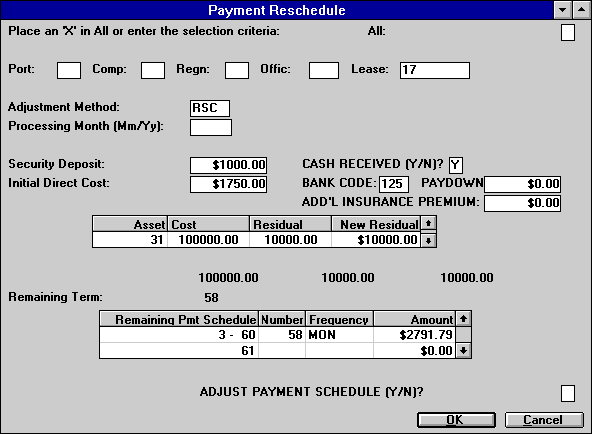
This
screen is used to verify the intended modifications to payment schedule and appears
only if the ADJUSTMENT METHOD is RSC. Asset information is not displayed for operating
leases
Auto Lease Extension: If the lease term is modified, i.e., the
lease maturity date is changed, the automatic lease extension record’s extension
start date will be adjusted accordingly. If the lease is changed to month-to-month,
the auto lease extension record will be removed. If there is an error removing
the auto lease extension record, LeasePak will provide a warning message: MTM
lease. Use [U0108] to delete auto lease extension record.
If the lease maturity
date is changed, and the auto lease extension record contains Recurring Charge
information, LeasePak will provide a warning message: Warning: Use [U0108] to
change auto lease extension RCR dates.
DEF - Financial, Asset
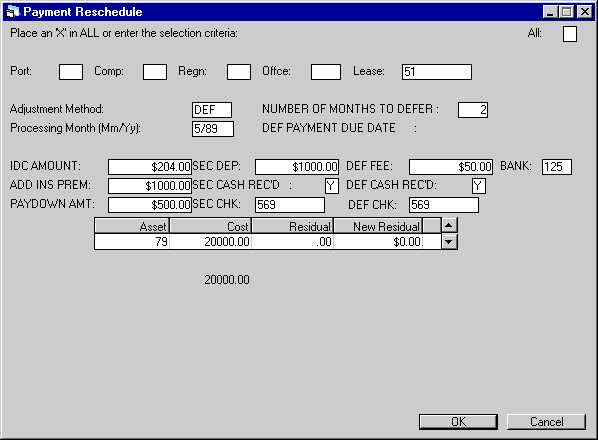
This screen appears when the DEF adjustment method is selected for the Payment Reschedule. When a DEF is made, LeasePak will perform edit checks based on the Ext/Def eligibility criteria set in the Miscellaneous Customizations of the Portfolio [U0212] update.
Field Description
- IDC
AMOUNT
The total IDC amount for the lease is displayed.
- ADD
INS PREM
The insurance premium for the lease is displayed or may be added.
- PAYDOWN AMOUNT
Enter the paydown amount for the lease
-
SEC DEP
Enter the security deposit, if any for the lease.
- CASH
RECD
Enter Y or N for security deposit cash received.
- SEC
CHECK NUMBER
Enter the check number for the security deposit. This field will display if the Security Deposit field has been populated.
- DEF
FEE
Enter the deferment fee for the payment reschedule.
- DEF
CASH RECD
Enter Y or N for deferment fee received.
- DEF
CHK
Enter the check number for the deferment fee received.
- BANK
Enter the default bank number for the lease.
- ASSET
The asset number for the lease displayed.
- COST
The total asset cost is displayed.
- RESIDUAL
The residual amount for the asset is displayed.
- NEW
RESIDUAL
Enter the new residual amount for the asset.
DEF - Payment Schedule
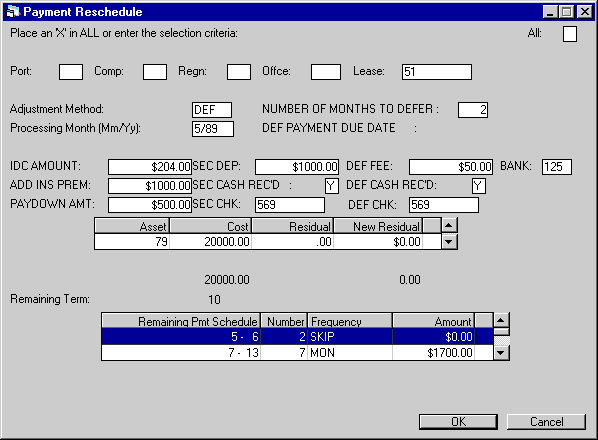
This screen displays the remaining term and the new payment schedule including the SKIP payments for the lease.
CPI - Payment Reschedule
Exception Report

The Payment Reschedule
Exception report [U0104A] provides the following information for each lease whose
attempted CPI method payment reschedule was unsuccessful.
- PORTFOLIO/COMPANY/REGION/OFFICE
The P/C/R/O is displayed.
- LEASE
The lease number is displayed.
- EXCEPTION
MESSAGE
Possible error messages in alphabetical order and their meanings are:
- FINANCIAL
INSTITUTION DOES NOT EXIST
The Financial Institution record does not exist on the Names (DRNM) file. Add the financial institution through the Financial Institution Name update [U0708].
- FLOAT
RATES RECORD DOES NOT EXIST
Float rates record does not exist on the Daily Base Rates (DRPR) file. Add the base rates through the Base Rates update [U0705].
- FAILED
TO UPDATE FILES
File updating could not be completed. This message indicates a data error. Notify your customer support representative at MSI.
- LEASE
ACCRUAL METHOD MUST BE PRECOMPUTED
Lessor accrual method is not precomputed and lease cannot be adjusted. Verify that this is the correct lease to be processed. If this is the correct lease, change the lessor accrual method to be a precomputed type using the Rebook update [U0116].
- LEASE
HAS VENDOR PARTICIPATION
Lease contains vendor participation and cannot be adjusted. Verify that this is the correct lease to be processed. If this is the correct lease, rebook it without vendor participation using the Rebook update [U0116].
- LEASE
HAS INVESTOR PARTICIPATION
Lease contains investor participation and cannot be adjusted. Verify that this is the correct lease to be processed. If this is the correct leas, rebook it without investor participation using the Rebook update [U0116].
- LEASE
IS AT THE MAXIMUM PAYMENT SCHEDULE
The lease is currently using all 360 payment schedule positions. No additional payment schedule entry may be made. Notify your customer support representative at MSI.
- LEASE
IS OUTSIDE PAYMENT SCHEDULE
The number of payments accrued does not match the lease’s payment schedule. This message indicates a data error. Notify your customer support representative at MSI.
- LEASE
MUST BE ACTIVE
Lease is not active (i.e., is paid off or charged off). Verify that this is the correct lease to be processed. If this is the correct lease to be processed, reverse the payoff using the Payoff Reversal option of the Payoff update [U0103] to return the lease to its status prior to the payoff.
- LEASE:
XXXX IS LOCKED
Where ‘xxxx’ is the lease number. The Lease record on the Lease (DRLS) file is locked. Try executing the Payment Reschedule update [U0104] again.
- NO
EXCEPTIONS FOUND
No errors were detected. All updating completed successfully.
- PORTFOLIO:
XXXX DOES NOT EXIST
Where ‘xxxx’ is the portfolio number. The portfolio record on the Portfolio (DRAP) file does not exist. This message indicates a data error. Notify your customer support representative at MSI.
- PORTFOLIO:
XXXX IS LOCKED
Where ‘xxxx’ is the portfolio number. The portfolio record on the Portfolio (DRAP) file is locked. Try executing the Payment Reschedule update [U0104] again.
- PORTFOLIO:
XXXX NEXT READ 1 FAILED
Where ‘xxxx’ is the last portfolio number read. This message indicates a data error. Notify your customer support representative at MSI.
- PORTFOLIO:
XXXX NEXT READ 2 FAILED
Where ‘xxxx’ is the last portfolio number read. This message indicates a data error. Notify your customer support representative at MSI.
- YIELD
COULD NOT BE CALCULATED
A yield could not be calculated with the adjusted financial information. This message indicates a data error. Notify your customer support representative at MSI.
RSC - Payment Reschedule
Audit Report
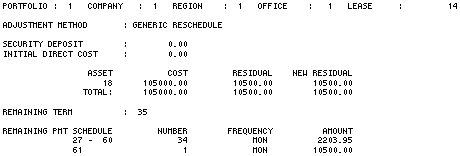
The Payment Reschedule
Audit report [U0104B] provides the following information for each lease whose
payment schedule is changed using the RSC ADJUSTMENT METHOD.
For detailed
information on the data shown on the report, refer to their field descriptions
on the previous Payment Reschedule update screens.
LeasePak Reference Guide
©
by McCue Systems Incorporated. All rights reserved.
The information contained in this document is the property of McCue Systems, Inc. Use of the information contained herein is restricted. Conditions of use are subject to change without notice. McCue Systems, Inc. assumes no liability for any inaccuracy that may appear in this document; the contents of this document do not constitute a promise or warranty. The software described in this document is furnished under license and may be used or copied only in accordance with the terms of said license. Unauthorized use, alteration, or reproduction of this document without the written consent of McCue Systems, Inc. is prohibited.